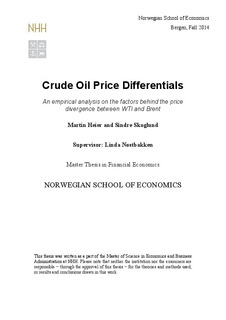| dc.description.abstract | The main purpose of
our thesis is to examine the long
-
run
relationship be
tween WTI
and Bren
t
.
Historically, the prices fluctuated around a constant differential, where
WTI traded above Brent due to its slightly higher quality.
Recently, the differential
has been reversed as B
rent has traded at a premium to WTI since 2010.
We analyze
the unusual behavior in
the
price
relationship
with
the use of an Engle
-
Granger two
-
step test for cointegration to assess if the relationship has ended
,
and whether a new
has been formed. We also d
ecompose the
WTI
-
Brent
spread
to examine if the
deviation
can be accrued to supply or demand
conditions
. Finally, we build
an
empirical model to
determine
what factors
have
had
a significant impact on
the
spread’s divergence.
We find that the long
-
run
rel
ationship between WTI and Brent ended in January 2010,
and
that
a new relationship
was established
early
2014.
However, the new relationship
is different from its predecessor as Brent is now
being
traded at a premium to WTI.
From our empirical findings
we
infer
that
insufficient
pipeline infrastructure
at
Cushing is significant in explaining the spread’s divergence. We also
conclude
that
shipping costs
significantly
affected
the spread
and
have
prolong
ed the divergence
between WTI and Brent
. | nb_NO |
